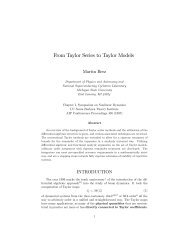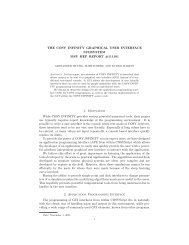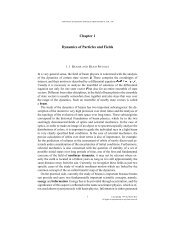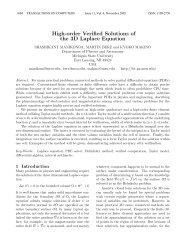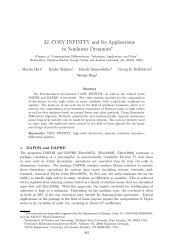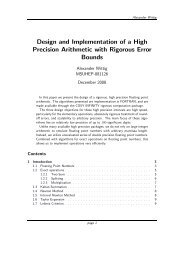Analytical Properties of Power Series on Levi-Civita Fields 1 ...
Analytical Properties of Power Series on Levi-Civita Fields 1 ...
Analytical Properties of Power Series on Levi-Civita Fields 1 ...
You also want an ePaper? Increase the reach of your titles
YUMPU automatically turns print PDFs into web optimized ePapers that Google loves.
K. Shamseddine and M. Berz<br />
there exists a finite δ > 0 in R, and there exists a regular sequence (a n (x))<br />
in R such that, under weak c<strong>on</strong>vergence, f (y) = ∑ ∞<br />
n=0 a n (x) (y − x) n for all<br />
y ∈ (x − δ, x + δ) ∩ [a, b].<br />
Definiti<strong>on</strong> 4.2: Let a < b in R be such that t = λ(b − a) ≠ 0 and let<br />
f : [a, b] → R. Then we say that f is R-analytic <strong>on</strong> [a, b] if the functi<strong>on</strong><br />
F : [d −t a, d −t b] → R, given by F (x) = f(d t x), is R-analytic <strong>on</strong> [d −t a, d −t b].<br />
Lemma 4.3: Let a, b ∈ R be such that 0 < b − a ∼ 1, let f, g : [a, b] → R<br />
be R-analytic <strong>on</strong> [a, b] and let α ∈ R be given. Then f + αg and f · g are<br />
R-analytic <strong>on</strong> [a, b].<br />
Pro<str<strong>on</strong>g>of</str<strong>on</strong>g>: The pro<str<strong>on</strong>g>of</str<strong>on</strong>g> <str<strong>on</strong>g>of</str<strong>on</strong>g> the first part is straightforward; so we present here<br />
<strong>on</strong>ly the pro<str<strong>on</strong>g>of</str<strong>on</strong>g> <str<strong>on</strong>g>of</str<strong>on</strong>g> the sec<strong>on</strong>d part. Let x ∈ [a, b] be given. Then there exist<br />
finite δ 1 > 0 and δ 2 > 0, and there exist regular sequences (a n ) and (b n ) in R<br />
such that f (x + h) = ∑ ∞<br />
n=0 a nh n for 0 ≤ |h| < δ 1 and g (x + h) = ∑ ∞<br />
n=0 b nh n<br />
for 0 ≤ |h| < δ 2 . Let δ = min {δ 1 /2, δ 2 / 2}. Then 0 < δ ∼ 1. For each n,<br />
let c n = ∑ n<br />
j=0 a jb n−j . Then the sequence (c n ) is regular. Since ∑ ∞<br />
n=0 a nh n<br />
c<strong>on</strong>verges<br />
∑<br />
weakly for all h such that x + h ∈ [a, b] and 0 ≤ |h| < δ 1 , so does<br />
∞<br />
n=0 a n [t] h n for all t ∈ ⋃ ∞<br />
n=0 supp(a n) . Hence ∑ ∞<br />
n=0 |(a n [t] h n ) [q]| c<strong>on</strong>verges<br />
in R for all q ∈ Q, for all t ∈ ⋃ ∞<br />
n=0 supp(a n) and for all h satisfying x + h ∈<br />
[a, b], 0 ≤ |h| < 3δ/2 and |h| ≉ 3δ/2.<br />
Now let h ∈ R be such that x + h ∈ [a, b] and 0 ≤ |h| < δ. Then<br />
∞∑<br />
|(a n h n ) [q]| =<br />
n=0<br />
≤<br />
∞∑<br />
∣<br />
n=0<br />
∑<br />
q 1 ∈ supp(a n ), q 2 ∈ supp(h n )<br />
q 1 + q 2 = q<br />
∑<br />
q 1 ∈ ⋃ ∞<br />
n=0 supp(a n), q 2 ∈ ⋃ ∞<br />
n=0 supp(h n )<br />
q 1 + q 2 = q<br />
a n [q 1 ] h n [q 2 ]<br />
∣<br />
∞∑<br />
|a n [q 1 ]| |h n [q 2 ]| .<br />
Since ∑ ∞<br />
n=0 |a n [q 1 ]| |h n [q 2 ]| c<strong>on</strong>verges in R and since <strong>on</strong>ly finitely many terms<br />
c<strong>on</strong>tribute to the first sum by regularity, we obtain that ∑ ∞<br />
n=0 |(a nh n ) [q]|<br />
c<strong>on</strong>verges for each q ∈ Q. Since ∑ ∞<br />
n=0 a nh n c<strong>on</strong>verges absolutely weakly,<br />
since ∑ ∞<br />
n=0 b nh n c<strong>on</strong>verges weakly and since the sequences ( ∑ n<br />
m=0 a mh m )<br />
and ( ∑ n<br />
m=0 b mh m ) are both regular, we obtain that ∑ ∞<br />
n=0 a nh n ·∑∞<br />
∑ n=0 b nh n =<br />
∞<br />
n=0 c nh n ; hence (f · g) (x + h) = ∑ ∞<br />
n=0 c nh n . This is true for all x ∈ [a, b] ;<br />
hence (f · g) is R-analytic <strong>on</strong> [a, b].<br />
14<br />
n=0



